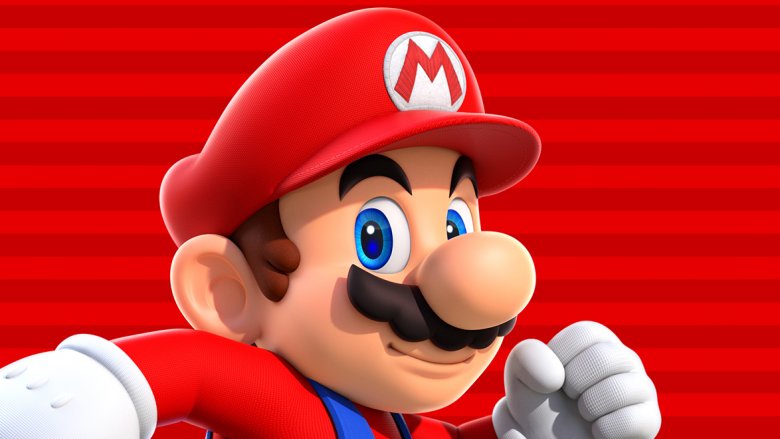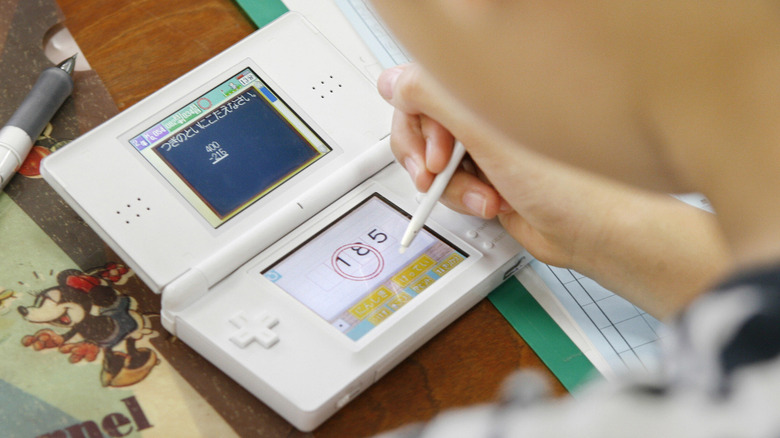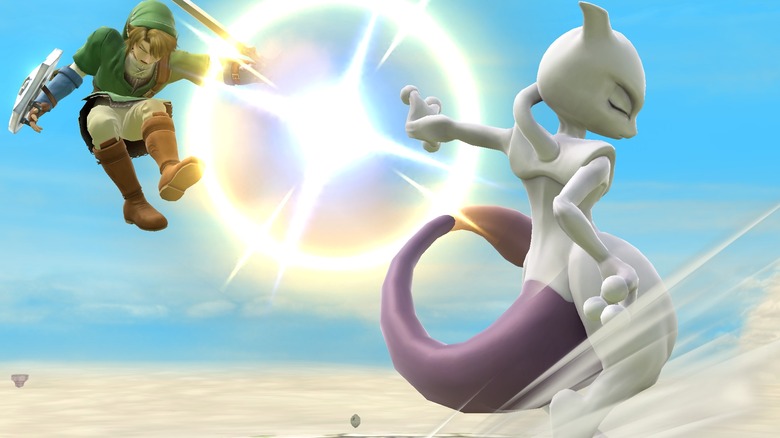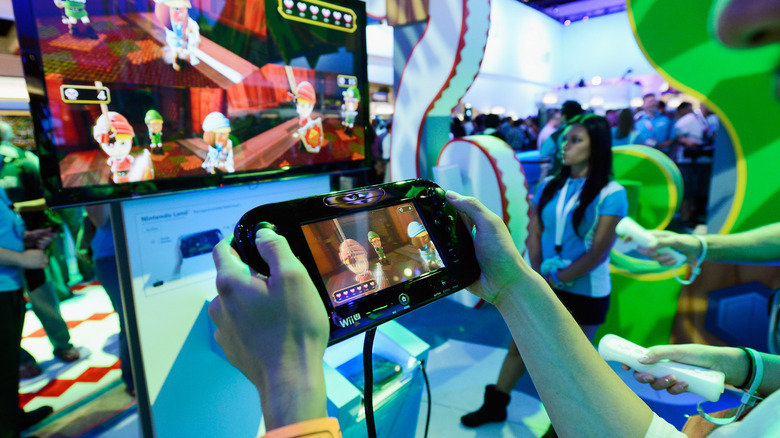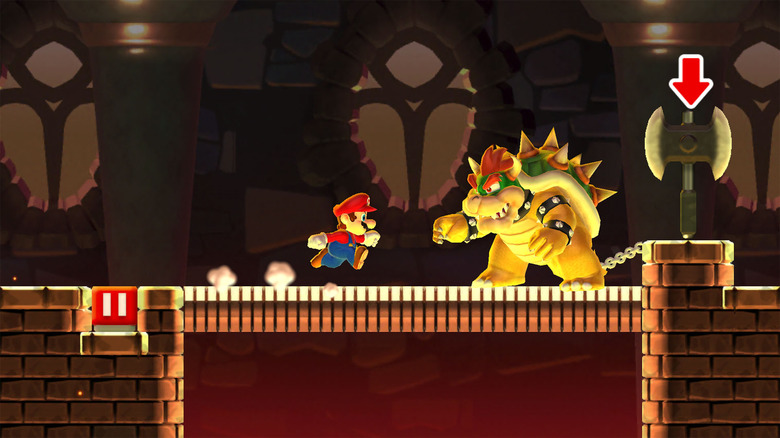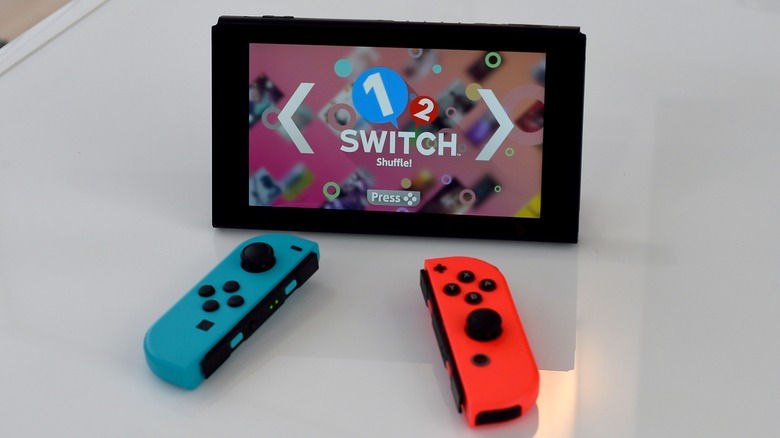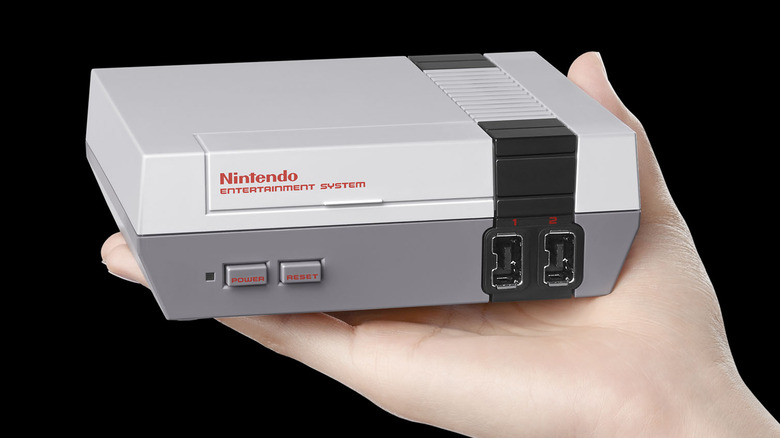When Nintendo Lied To Us
Companies aren't your friends–not even the ones you grew up with, like Nintendo. Sure, you might've spent countless hours exploring the Mushroom Kingdom, Hyrule, Zebes, Deam Land, and Kong Isle, but Nintendo doesn't actually care about you. It just about cares about your money, and it'll do anything to get it, including lying straight to your face.
Okay, so maybe that's a little harsh. But for years, the legendary gaming giant has developed a nasty habit of saying something that turns out to be way less than true–or outright false. People change their minds, and things don't always go according to plan. But still: Nintendo has made more bogus statements and announcements than you probably ever imagined. Such as...
The DS will be a third pillar in Nintendo's line-up
Despite its boxy design and itty-bitty green and black screen, the Nintendo Game Boy was very, very popular. Nintendo sold 118.7 million units of the Game Boy and its upgraded edition, the Game Boy Color, between 1989 and 2003. Fans bought another 81.5 million units of the Game Boy's successor, the Game Boy Advance. During the '90s, companies like Sega and Atari released handhelds that were technically superior to Nintendo's little portable, but the extra power didn't matter. For 15 years, the Game Boy brand was king.
Eventually Nintendo unveiled its next handheld, a weird little machine called the DS. Like the Game Boy, you could put it in your pocket for on-the-go gaming. Unlike the Game Boy, the DS had two screens, one of which responded to touch. It came with a stylus, and ran old Game Boy Advance games, too.
At the time, no one was sure what this new oddity meant for the Game Boy brand. While hyping the DS, Nintendo executives, including Mario and Zelda creator Shigeru Miyamoto, implied the Game Boy wasn't going anywhere. According to Nintendo, the DS wasn't a replacement for anything. It was a "third pillar" to complement both the Game Boy line and Nintendo's home consoles.
That wasn't true. The DS quickly replaced the Game Boy Advance as the market's favorite portable. While Nintendo tried to keep the Game Boy alive, the more-powerful DS overshadowed it. Soon, Nintendo abandoned the Game Boy brand entirely. That proved to be the right call. Nintendo ended up selling over 154 million Nintendo DS devices, making it the second-best-selling video game console, handheld or otherwise, of all time.
Super Smash Bros. 4 won't have paid downloadable content
Thank goodness for downloadable content. Super Smash Bros. for Nintendo 3DS and Wii U (colloquially known as Super Smash Bros. 4) shipped with 51 playable characters—including the Mii fighter, who comes in three different forms—and yet not everyone's favorite fighters made the cut. Initially, popular characters like Lucas and Mewtwo were missing from Super Smash Bros. 4 at launch, but fans didn't give up hope. After all, downloadable add-ons are de rigueur in modern video games, and it seemed like a sure bet that Nintendo would flesh out Super Smash Bros. 4's roster in the future through some extra digital content.
Even better, Smash director Masahiro Sakurai heavily implied that Nintendo wouldn't charge extra money for new characters and stages. "I think there might be criticism that we are cutting up content to sell characters one by one," Sakurai told VideoGamer, "or that we are adding things later that should have been there from the start." He continued, "What I can say now about paid DLC is that we aren't working on anything at the moment."
Notice that Sakurai says paid DLC. When Super Smash Bros. 4 debuted, players could download the legendary Pokémon Mewtwo for free as long as they'd purchased the game on both the Wii U and the 3DS. Combined with Sakurai's statements, fans assumed that Nintendo wasn't going to charge for more content. Alas, it wasn't to be: even as Sakurai called for-pay DLC an "epidemic" and a "scam," he announced that extra characters and levels would cost real-life money. So yes, you can play Super Smash Bros. 4 as Ryu or Bayonetta—but, unfortunately, you're going to have to pay for it.
The Wii U wouldn't repeat the mistakes of the 3DS
It's easy to forget, but the Nintendo 3DS got off to a very slow start. Since its debut, Nintendo moved almost 70 million units—more than the Nintendo Entertainment System, the Super NES, or the Nintendo 64—but at the beginning, the little handheld seemed doomed. In fact, the 3DS' performance was so bad that Nintendo dialed their initial sales estimates way back and cut the price by $80 just a few months after its debut just to keep the portable alive.
Officially, Nintendo blamed a lack of quality launch games for the 3DS' struggles, but there were other factors at play, too. The system's signature gimmick, glasses-free 3D images, didn't work well, and at $250, it was a hard sell. After all, at the time, you could get an Xbox 360 for a mere $50 more—and a Wii for $50 less.
In the lead up to the launch of the Wii U, which came out roughly a year and a half after the 3DS, Nintendo CEO Satoru Iwata promised that the company had learned from its missteps. "We won't make the same mistake that we did with the 3DS," he told the Yomiuri Shimbun Daily (via Techno Buffalo ), especially when it came to pricing. And yet, when the Wii U launched, it had very few games, confused consumers, and cost a whopping $350. As with the 3DS, Nintendo tried to jump-start the system with a price cut, but this time the damage was already done. By the end of its brief run, the Wii U cemented its legacy as the second worst-selling Nintendo console of all time, topped only by the even worse-off Virtual Boy.
The Wii Vitality Sensor exists, for real
At E3 2009, right when the Wii was at the height of its popularity, Nintendo spent a large portion of its annual press conference detailing a brand new peripheral called the Wii Vitality Sensor. Nintendo CEO Satoru Iwata himself took to the stage to describe the device, which clipped on to users' fingers and measured their heart rates in order to tell how excited they were (or weren't). Iwata claimed that the sensor could be used in games that "help people unwind or even fall asleep," and would expand the gaming audience a la the Wii's motion controls and the Wii Fit health package.
Audiences responded to the announcement with tepid confusion, and they never really got answers. A year later, Shigeru Miyamoto told IGN that Nintendo was still working on the device, and that E3 simply wasn't the best place to show it off. In 2011, two years after the Wii Vitality Sensor made its E3 debut, Nintendo promised investors that the device was still under development. The company repeated those claims at that year's E3, although Miyamoto noted that Nintendo was having trouble getting the device to work properly.
Ultimately, it was all for nothing. In 2013, Iwata confirmed that the Vitality Sensor was dead. According to Iwata, the device didn't work reliably with about 10% of users, which wasn't good enough for Nintendo. And so, the whole project was axed, marking the end of one of the weirdest ideas in Nintendo's history (that we know about, at least).
Nintendo and Sony are collaborating on a CD-based console
In the infamous saga of the Nintendo PlayStation, Nintendo didn't just lie to the public. They lied to their business partner, accidentally creating their biggest competitor in the process.
It's a complicated story, but here's the gist of it: in 1988, Sony and Nintendo teamed up to create a CD-based add-on for the Super Nintendo Entertainment System, as well as a separate console that would play both SNES cartridges and CD-ROMs. The CDs would be coded in a proprietary format that Sony called Super Discs, which Sony would control. Nintendo decided that the deal gave Sony too much power. So while Sony developed the two consoles, Nintendo made a separate deal with Phillips, which had recently released the CD-i home entertainment system. Under the new deal, Nintendo's popular characters would appear on the CD-i, while Phillips would help Nintendo develop a new CD-ROM attachment for the SNES.
But nobody told Sony. At the 1991 Consumer Electronics Show, Sony unveiled the Nintendo Play Station. The very next day, Nintendo betrayed Sony and announced that it would be teaming up with Phillips instead. Sony's execs were irate. The company scrapped the original PlayStation in order to make its own console, and the game industry changed forever.
And of course, that Phillips-made SNES attachment never arrived either, meaning that the only things that Nintendo got out of the debacle were some of the worst games ever made, which also happened to star its flagship characters. Whoops.
The 64DD is coming west
The Nintendo 64 had a lot of add-ons, and many of them were pretty neat. The Rumble Pak, which shipped with Star Fox 64, helped make force feedback a standard feature for console gamepads. The Transfer Pak connected to Game Boy cartridges, pulling off tricks like importing your hard-earned Pokémon into other games, like Pokémon Stadium. The Expansion Pak, which gave the Nintendo 64 more RAM to play with, boosted the graphics in games like Resident Evil 2 and was required for resource-heavy games like Donkey Kong 64 and Perfect Dark.
But none of those sounded quite as cool as the 64DD, a disk drive peripheral that Nintendo hyped up big time before the Nintendo 64's launch. The 64DD's rewritable disks could be used to add new levels, quests, and characters to existing games, Nintendo said, or to store and share user-created content. It was kind of like DLC or the Steam Workshop, but it was set to debut in the mid-90s, before every suburban home had internet access (although the 64DD could go online, too).
Best of all, unlike Nintendo's last disk drive peripheral, the 64DD was definitely going to come to America. No question about it.
It didn't. Prototypes of the American 64DD exist, but the device never got a retail release on western shores. It didn't do so hot in Japan, either. After a number of delays, the 64DD launched with only nine games to its name, and was discontinued a few months later.
Nintendo would never release smartphone games
The biggest weapon in Nintendo's arsenal is its iconic cast of characters. Traditionally, if you wanted to play the latest games starring Mario, Link, Samus, and Kirby, you needed a Nintendo console. Otherwise, you'd be out of luck.
But with the rise of smartphones, people's gaming habits are changing. Still, in 2011, Nintendo president Satoru Iwata told the Japanese newspaper Nikkei that the company would "absolutely not" create games for other people's mobile devices. "If we did this, Nintendo would cease to be Nintendo," Iwata said. While he admitted that putting Nintendo games on phones would probably lead to an immediate boost in profits, he didn't think that it would be the best thing for the company long term.
Four years later, Iwata told a very different story. In 2015, Nintendo announced a partnership with mobile game developer DeNA, which would see the two companies team up to bring Nintendo's characters to smartphones. Iwata was still committed to Nintendo's own hardware, but now saw mobile games as a way of acquainting new players with Nintendo's iconic characters. These days, Miitopia, Super Mario Run, Fire Emblem Heroes, and Animal Crossing: Pocket Camp are fixtures on phones all over the world—and Nintendo is just getting started. Expect more to come.
No friend codes on the Nintendo Switch
Nintendo can't get online right. Consider Friend Codes. When the DS launched in 2006, the only way to team up with buddies in games like Mario Kart DS, Pokémon Diamond, and Animal Crossing: Wild World was to input a randomly assigned 12-digit identifier into each game and pray you didn't have any typos. It was cumbersome and annoying—especially since Xbox Live and the PlayStation Network let real-life friends connect via easy to remember usernames. Yet Friend Codes stuck around for the 3DS, Wii, and Nintendo's mobile games (the Wii U has many problems, but Friend Codes aren't one of them).
In the lead-up to the Nintendo Switch's debut, however, it seemed like Nintendo had finally learned its lesson. For the first time, Nintendo promised that the Switch would have a fully-functional online network, with standard features like voice chat and matchmaking lobbies—y'know, the things that other companies have been offering for over a decade. Even better, it was finally going to be easy to connect with friends. "There are no friend codes within what we're doing," Nintendo of America president Reggie Fils-Aime told CNET.
And then the Switch arrived and, guess what? Friend codes are back. It's an archaic system that feels out of place in modern gaming. Eventually, Nintendo might offer an alternative system. In the meantime, get ready to swap numbers—and don't trust a word that Reggie says ever again.
The NES Classic Edition is discontinued
When Nintendo first unveiled the NES Classic Edition, a palm-sized console that plays a handful of old-school Nintendo games, the company made it very clear that the device wasn't supposed to be a permanent addition to Nintendo's line-up. At launch, the machine was incredibly hard to find due to limited stock. Six months later, Nintendo discontinued the product entirely, telling IGN that "the NES Classic Edition wasn't intended to be an ongoing, long-term product." It was definitely, absolutely, for certain not making any more.
In dismay, some fans turned to eBay and Amazon's third-party sellers to pay hiked prices for the limited edition device, while others simply wallowed in their disappointment. Thankfully, relief was on the way. Just a few months after Nintendo stopped producing the NES Classic Edition, the company pulled an about-face and decided that no, actually, more NES Classic Edition consoles are coming. You're just going to have to wait a little bit longer to get them.
As of this writing, the NES Classic Edition is scheduled to resume production in 2018, with a return to stores sometime thereafter. That probably isn't going to soothe fans who forked out $1,000 to scalpers to get one of the mini-consoles, but it's great news for everyone else who missed out the first time around. Besides, Nintendo's change of heart shows that not every lie is malicious. Sometimes, breaking promises ends up being better for everyone, Nintendo-fans included.

